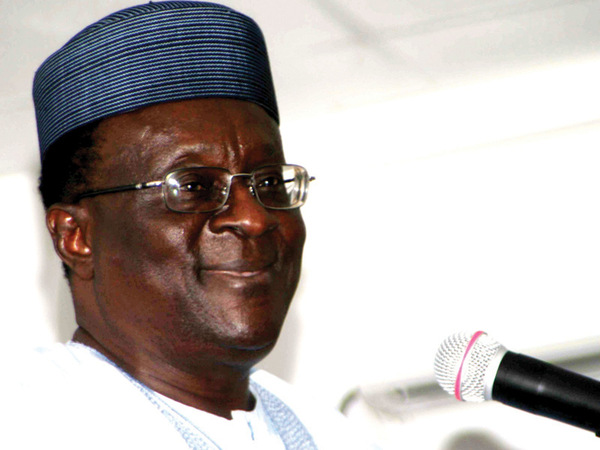BY THADDEUS ONOJA AKPA
Gazing at the neatly set wooden ceiling above the serene and sacred chapel, the terrazzo flooring and the immovable altar topped by a slab of natural stone: the superb piece of circular architecture sits at the very centre of St. Kizito Seminary, Idah in Kogi state surrounded with hard-wearing stone pitched interlock, termite proof and will virtually last forever, one gets the sense of the footnote to the personality of that great Church man and Venerable father, Bishop Ephraim Silas Obot.
Glancing through the entrance of the Chapel greets you with the aura of God’s presence, and indeed our hearts yearn, it pants for the house of the Lord, for it is better to be a tent keeper in the house of the Lord than to dwell in the tents of wickedness .
The ceremonies that led to the dedication of that lovely dwelling place witnessed the presence of Archbishop Peter Akwai Sarpong of the Archdiocese of Kumasi, Ghana, now Emeritus, a great friend of Bishop Obot, and Archbishop Gabriel Gonsum Ganaka, the then Archbishop of Jos. The attendance of these personalities among many others for the opening of a minor seminary chapel, gives an indicator to how dear St. Kizito Seminary was to the heart of Bishop Obot.
Advertisement
Bishop Obot practically brought Igala land to the Google map with the establishment of St. Kizito Seminary, Idah. This institution has become a universal landmark, one of the foremost in Kogi East.
BISHOP OBOT AND THE DESIRE TO LEAVE A LASTING LEGACY
His prime desire was to establish a nursery bed for the fostering of vocations and indigenous clergy. This he did and did so well. The 1917 Code of the Canon Law describes the purpose of minor seminaries as: “to take care especially to protect from the contagion of the world, to train in piety, to imbue with the rudiments of literary studies and foster in them the seed of a divine vocation”.
Advertisement
Indeed that is what it was. A typical day in the seminary begins at 5:15 am with the rising bell and the chants of “Benedicamus Domino”- let us bless the Lord, and the response of “Deo Gratias”- thanks be to God. Then follows the sequence: Laudatur Yesu Christus” and the response of “In Vitam Aeternam” “Unto life everlasting.”
Thus begins the day, with Morning prayers: “Let us place ourselves in the presence of the Lord and adore Him… O Jesus Living in Mary”. The prayers led to the morning Mass, then Morning functions and breakfast. I still remember the hot beans we ate like a Passover as we rushed to the assembly grounds and off to class, singing Babylon has fallen, fallen to rise no more!
Lectures were a marathon. No space to breathe apart from break time, it was so regimented, sometimes I wonder how I even coped, no provisions and all that. We enjoyed lectures: we had great teachers; Mr. Ajodo (now Late), Mr. Vincent Akpala, Mr. Isidore Udonna, Mr. Nwakaego, Alfred Okolo and Edward Salifu. The Rectors ensured we had the best. Very Rev. Fr. John Abuh started with us as Rector and lasted till we finished in 1999 and beyond.
After lectures, we marched to the Chapel to recite the litany of the Holy name of Jesus, it never made much impact on us then as we were tired and hungry, imagine such a hallowed prayer, now that I am older, it does make so much impact. But then we could not wait for the Oje Akpa and Obo Egwa(beans soup) waiting for us in the refectory and siesta time was nonnegotiable, save for those destined for punishment and many were notorious for being culprits.
Advertisement
Afternoon prep was one of my best moments after a great siesta, then games or labour followed. Evening prayers and Rosary came next at 6:30pm. I did prefer the strolling rosary, then supper of maybe jollof rice or yam and stew. We had some good moments of break time and followed by Night prep and it ends with Night prayers.
The seniors continued with extension for one hour, which I hardly participated because I could not wait to embrace my bed, I am not really a night person, I preferred to wake up in the early hours, say 3am or 4am to read, it made more meaning to me then.
We had social gatherings, debate, quiz and sports, I was not a great sportsman though I was good at track events. We engaged neighboring schools too in every sphere, many students loved the interaction with the Holy Rosary College on days of YCS – Young Catholic Students.
St. Kizito meant a lot to many people. 80% of the friends I have today are either from St. Kizito or linked to people from St. Kizito. The impact was monumental. God bless the brains that birthed that noble institution.
Advertisement
Bishop Obot was a passionate lover of the priesthood. He was a Churchman in the truest sense of the word, he was a man of the encyclicals, a lover of knowledge, no wonder he established so many schools and institutions in his lifetime. Of all the institutions he established, I doubt if there was any other dearer to his heart than St. Kizito Seminary. He constantly visited us in the school, he came for the formal investiture of the new students, where our school uniforms were blessed before we could wear them. I can hardly doubt if the seminary was not on the list of the places Bishop Obot would have loved to have been buried.
He brought his friends to see us in school. There were times the school program had to be adjusted to accommodate audience with the seminarians. I will not forget, that it was on such occasions we met notable figures like Archbishop Peter Sarpong of Kumasi, Ghana, Archbishop Carlo Maria Vigano, the then Papal Nuncio to Nigeria, the Catholic Women from Fulda in Germany and many more.
Advertisement
One of our darling moments as minor seminarians then, was the cow we got at Easter. As funny as it might sound, we longed for it and planned for it. In those days it was a rare delicacy to have a piece of meat in your food, the joy and celebration those days started with the preparation for the Chrism/Cathedraticum Mass. We had our red/white check dresses washed and well ironed. Some added candle wax while ironing, to give the shorts a nicer glistening look, some of the knive-ironed edge called creases or “gator” of the shorts/trousers as we called them could even injure you due to the precision with which it was ironed.
We had practiced “O Redemptor” and found our way to the Cathedral of St. Boniface for the ceremony; both the Catedraticum and Chrism Masses were combined those days. We all waited patiently for parishes like Sacred Heart, Ankpa, St. Joseph, Anyigba and St. Boniface to make their donations. We were so sure that the bursar of the school will bring us a cow, Bishop Obot ensured that. These were the concerns of our little minds. It is quite interesting that Cathedraticum now has advanced, and done on Deanery basis to bring the Bishop closer to the people and even outstations now donate cows.
Advertisement
Whatever happened to the cow meat and how it was shared is matter for another day, as seniors will get the lion’s share, we, the junior and smaller ones waited for the crumbs that fell from the master’s table but as we advanced, a lot of access was secured, as a Senior Prefect and as an auxiliary, I had more to eat and to spare. This is on a lighter note though.
Bishop Obot, with the establishment of St. Kizito Seminary, fast tracked the development, growth and advancement of Idah Diocese and Igala land as a whole. With the Seminary, he gave Idah Diocese the man power, technical knowhow, spiritual base, intellectual muscle and music mien that Idah diocese relishes today and forever. There is hardly a priest who does not have a tale of St. Kizito, either as a minor seminarian, major seminarian or priest. Ninety per cent of our priests and seminarians either schooled, or worked in that hallowed institution.
Advertisement
BISHOP OBOT: TEN YEARS SO SOON
It was early Easter Sunday Morning that Bishop Obot transited to the heavenly realm. I was a young deacon at the Cathedral and had just returned from service at Alade and Orogun. Even the very town of Idah wore an eerie foreboding, and it only took time before I got to know what had happened. I laid on my bed to catch some nap but was awoken by a major seminarian, he whispered to me, ‘Attai le!!! (Baba is gone).
All that transpired after then is now history. We had Mass for him at his residence and after that, I joined my Principal, the then Cathedral Administrator Rev. Fr. Godwin Atede, to accompany the corpse to the Annunciation Hospital Mortuary, Enugu.
I may have been too young to have had a close interaction with this magnificent prelate but as seminarians, we had sessions with him, thanks to his love for the minor seminary, we loved it and I dare say that it gave us a sense of pride and air of self-importance too.
As the Senior Prefect then, I had the arduous task to convey our condolence to the Bishop when he lost a member of the family, poor me, I fidgeted in his presence, I am sure he would have insisted his minor seminarians go to Abuja when Pope John Paul II visited Nigeria in 1998. I saw the Pope; I have seen a Saint, all thanks to Bishop Obot’s love and care for the seminary and the seminarians.
As Major seminarians we watched Bishop Obot’s steps slow down, we heard he was ill, but he bore it with stoic fortitude. We witnessed him going down, losing weight. After my pastoral year in 2005, he asked to see us. As usual, a teacher that he was, every opportunity for him was to teach. At the prayer “‘Blessed be the Holy and Undivided Trinity, Now and Forever’ he told us, this is one of the most ancient prayers of the Church”. He told us why St. Theresa of the Child Jesus was the secondary patron of the Missions, we didn’t know, he told us ‘because she prayed for the missions’. He also taught us that St. Francis Xavier was the primary patron of the Missions.
As a deacon I experienced him more closely, we barely saw Bishop Obot, though he still came to the office, he had gotten an auxiliary Bishop, Most Rev. Dr. Anthony Ademu Adaji, MSP. My last encounter with him was after the death of his brother, Bishop Obot blessed me and that was it. May God rest his beautiful soul.
ESTABLISHMENT OF ST. KIZITO SEMINARY, IDAH, A JEWEL IN THE SAVANNAH
Idah, where St. Kizito is located, is an ancient city drenched in history, it lies beside the undying flow of the river Niger. The freshness of the air blowing from the river as you meander through Okpachala to Idah invites you to the prehistoric city of the Igalas that smells of tradition, stories and myths. This land of Ayegba is indeed blessed with a great countryside with the ox-bow lakes of Ofiaye and the one hundred steps down the slope to Ocheche along the banks of the River Niger.
Strolling through the course of the river down to Ega, exposes the cliff that stands impressively at the banks of the river. These were natural strongholds used by the fighters of old as a tower of guard to protect the Kingdom from encroaching armies and tribes. It served as a bastion of defense when the kingdom engaged the Benin in the Idah-Benin war of 1515-1516 that ushered in the Igala Empire as sovereignty to be feared and revered. One of the insignia of office worn by the Attah, Ejubejuailo is a relic of this war.
From the eastern flank of Idah is the famous Inachalo River whose fish does not get cooked, these strange fishes were effects of the Igala-Jukun war which is arguably a distant account of the use of chemical weapons in the art of warfare. From the Inachalo river, the road leads to Akpatega into Iyegwu where St. Kizito the home of the humble, sits majestically on the right.
The entrance avenue neatly dotted with well cut ornamental trees passes a single message. “Welcome to St. Kizito”. The main avenue is beautifully laid in interlocking tiles down to the chapel which is at the centre of the institution, with a Marian grotto by the right and the statue of St. Kizito.
St. Kizito boasts of a state of the arts science laboratory, computer café and library. The hostels of Sts. Joseph, Mary, Luke, John Bosco, Obot and Atta’s Hostels are living shrines to the countless kizito students who have passed through the school.
The school boasts of about four football fields, an athletic track and field, volleyball, basketball, lawn tennis, and handball and badminton courts. These fields have produced great footballers and athletes like Sunday Emmanuel and others. The class rooms are as old as the school and have housed different scores of persons over the years.
While in school Bishop Obot ensured we had the best of teachers, we had seminarians from Awka and Onitsha Archdioceses who taught us Atilogu dance, music and Latin. The level of influence of Kizito students or Kizitans as some people call them is felt in the level, value and appreciation of music in Idah Diocese and Beyond.
Bishop Obot brought the first music organ to the seminary, the Viscount in the early Nineties. Bishop Obot was a man of taste I must confess, he knew good things, and he had vision.
Whenever and wherever the story and history of Bishop Obot will be written, it will never be complete without a mention of St. Kizito Seminary, Iyegwu, Idah. The establishment of the seminary in 1982 did not come easy. It was not without its share of opposition as we were told.
Why a small rural diocese like Idah would start a minor seminary, was it sustainable, was it not a white elephant project? Bishop Obot laid the foundation with only one thing in mind: faith in the God of the missions. And this faith did not fail him. Minor seminarians of Igala extract who attended other minor seminaries, shared sad tales of their challenges and difficulties experienced there.
These reasons and coupled with the other needs as well as Bishop Obot’s prayer for vocations led to the establishment of St. Kizito Seminary Idah. Today every set that finished from St. Kizito Seminary has at least two priests. This is the Lord’s doing and it is marvelous in our eyes. Only God can estimate the value of the sacrifices made to build St. Kizito into what she is today.
The joy of Bishop Obot knew no bounds when the first priest from St. Kizito to be ordained a priest, Rev. Fr. James Ojo was ordained in 1995 and later Fr. Innocent Oyibo and Godwin Onuh, the next year, four seminarians were ordained: Rev. Frs. Samuel Akagwu, Sebastian Musa, Albert Shaibu and Anthony Eseke. Since then it has been a bountiful harvest. Bishop Obot had invested, it was now time to harvest and a bumper harvest it has been.
A Seminary as was the intention of the Church Fathers is a seed ground for the training of young men who aspire towards the Catholic priesthood after the mind of our Lord Jesus Christ. It has its pedigree in the Latin word seminarium, which is a nursery bed where vocations are formed for service as priests.
This was indeed necessary in order to meet adequately with the objectives of intellectual, human, pastoral and spiritual growth of the candidates in formation. It is explicitly stated in John Paul II’s Post-Synodal Apostolic Exhortation of 1992, Pastores Dabo Vobis, no.42:
The “seminary” in its different forms—and analogously the “house” of formation for religious priests—more than a place, a material space, should be a spiritual place, a way of life, an atmosphere that fosters and ensures a process of formation, so that the person who is called to the priesthood by God may become, with the sacrament of orders, a living image of Jesus Christ, head and shepherd of the Church.
THE SOCIO-CULTURAL IMPORTANCE OF THE ESTABLISHMENT OF ST. KIZITO SEMINARY
The quality improvement that the Igala and Bassa race has gained through the establishment of St. Kizito seminary will last as long as time. The school afforded a group of very few boys and young men access to qualitative education at a giveaway price. This was because the tradition of St. Kizito was to do well in the school and also in the world. Not all the students later became priests, but the quality of formation, Spartan discipline and management skills were enough to carry us through life, you thus hear of Kizito boys as doctors, engineers, captains of industries, lawyers, professors, name it. They are now all over the world, in various fields and excelling very well. I remember an ex student who told me that “if not for St. Kizito seminary, many of them would have ended up as farmers in the village”. All thanks to Bishop Obot. May He continue to rest in the place of refreshment, light and peace.
Bishop Adaji, MSP says it all in his Book, The Shepherd’s Voice, in the homily he gave on the occasion of the celebration of the Silver Jubilee of St. Kizito Seminary: “Our seminarians are our future. They are our hope”. He also commented in the same book that “St. Kizito Seminary has gradually emerged not only as a bedrock of vocation for our diocese, but also a cradle for intellectual training for future professionals” .
I thank God that I saw and met Bishop Obot, and being a beneficiary of this immense dream of his, the dream of a consummate scholar and gentleman. I was confirmed and admitted to the Major Seminary by Bishop Obot, trained by him and ordained by Bishop Adaji, a lover and mentee of Bishop Obot. There are very few men with such dedication to excellence and devotion to duty that Bishop Obot exhibited. This indeed rubbed off on many of us and the lasting legacy of Bishop Obot that the minor seminary of St. Kizito Idah is.
Thaddeus Onoja Akpa is Catholic Priest of the Diocese of Idah, Nigeria. He is an Author, Writer and Musician. You can reach him on WhatsApp 07030194226 and Twitter @akpaonoja.
Views expressed by contributors are strictly personal and not of TheCable.






